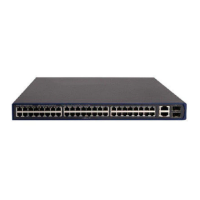118
Task Remarks
Creating an NQA test group Required
Configuring ICMP echo tests
Configuring DHCP tests
Configuring DNS tests
Configuring FTP tests
Configuring HTTP tests
Configuring UDP jitter tests
Configuring SNMP tests
Configuring TCP tests
Configuring UDP echo tests
Configuring voice tests
Configuring an NQA test group
Configuring DLSw tests
Required
Use any of the approaches.
Configuring the collaboration function Optional
Configuring threshold monitoring Optional
Configuring the NQA statistics collection function Optional
Configuring the history records saving function Optional
Configuring optional parameters for an NQA test group Optional
Configuring a schedule for an NQA test group Required
Configuring the NQA server
To perform TCP, UDP echo, UDP jitter, or voice tests, configure the NQA server on the peer device. The
NQA server responds to the probe packets sent from the NQA client by listening to the specified
destination address and port number.
Follow these steps to configure the NQA server:
To do… Use the command… Remarks
Enter system view system-view —
Enable the NQA server
nqa server enable
Required
Disabled by default.
Configure the listening
service
nqa server { tcp-connect |
udp-echo } ip-address
port-number
Required
The destination IP address and port number must be
the same as those configured on the NQA client. A
listening service must be unique on the NQA server.
Enabling the NQA client
Configurations on the NQA client take effect only when the NQA client is enabled.
Follow these steps to enable the NQA client:

